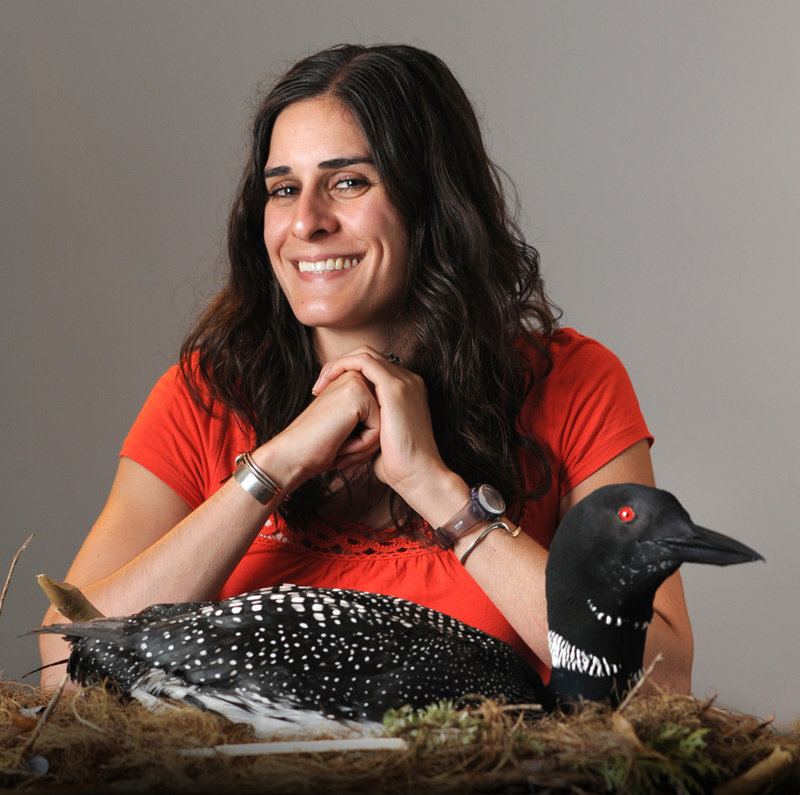A special sight out on a lake this time of year is a loon. To hear one calling in the middle of the night can be a precious experience, a barometer of sorts reaffirming the land is still wild and beautiful; that there’s magic and mystery unfolding right nearby.
The loon you may be hearing could have spent its first year on a Maine lake back when Ronald Reagan took office and the first Space Shuttle blasted off.
“Loons and eagles can live up to 30 years,” says Camilla Fecteau, biology instructor at Saint Joseph’s College.
But ever wonder what a certain loon call means? From 6:30 to 8 p.m. on Thursday, Fecteau will present a free talk at the Sebago Lake Ecology Center in Standish on “The Common Loon: Protecting a Symbol of Maine Wilderness.” Part of the discussion will be hearing different loon calls and what they signify. Kids are often particularly interested in this part of the program.
Fecteau says loons in our neck of the woods are still found in good numbers, but since fish with elevated levels of mercury make up nearly all of their diet, loons cannot avoid ingesting toxins. Just how this is affecting the birds is not clear.
“Because loons aren’t threatened at the state or federal level, some of the only information we have is that collected by volunteers on the annual loon count,” Fecteau said, “and that’s not a holistic picture of how loons are doing.”
It’s not just mercury. Lead is another hazard poisoning many of these water birds. Loons inadvertently ingest small discarded lead fishing weights when picking up and swallowing small stones, something they routinely do to help grind up and digest food since they have no teeth.
“Once a loon starts showing symptoms of lead poisoning, it’s too late to save,” Fecteau said. “A loon will get lethargic and beach itself; they have to be euthanized.”
Luckily our loons aren’t suffering quite as bad as others. Fecteau said loons in southern New England are particularly stressed. Maine water birds are fortunate in that we have many remote lakes and ponds free from lead fishing weights and development pressures.
“New Hampshire actually monitors every one of its water bodies in regards to loons,” Fecteau said. “They found the number one cause of mortality was lead-sinker poisoning.”
The image of a New England lake may invoke a pristine environment, like Henry David Thoreau at Walden Pond. But Fecteau said New England has some of the highest mercury levels in the nation because we are downwind from many coal-burning power plants.
“Loons in Massachusetts have the highest blood-mercury levels than anywhere else in the country,” she said.
Mercury pollution emitted by coal burning is carried by the wind and falls to earth with the rain. If you’re wondering why mercury gets concentrated in our waterways – prompting health officials to issue warnings about the consumption of fish, while not advising us against eating something like the potato crop – Fecteau says it’s because of what happens to that mercury. It’s essentially because bacteria in a waterway converts airborne mercury into its more potent cousin, methyl-mercury.
“That’s when it starts accumulating and building up in the food chain,” Fecteau said.
As part of the effort to reduce the amount of lead sinkers that can get in our waterways and end up killing loons, lead-free sinkers of tin and ceramic will be given to those who attend the Fecteau’s talk.
Registration is required. Call Lynne Richard at 774-5961, ext. 3324 to register. The Sebago Lake Ecology Center is run by the Portland Water District and is located at the corner of Route 35 abd Route 237. The entrance is on Route 237.
Don Perkins is a freelance writer who lives in Raymond. He can be reached at: presswriter@gmail.com
Send questions/comments to the editors.



Success. Please wait for the page to reload. If the page does not reload within 5 seconds, please refresh the page.
Enter your email and password to access comments.
Hi, to comment on stories you must . This profile is in addition to your subscription and website login.
Already have a commenting profile? .
Invalid username/password.
Please check your email to confirm and complete your registration.
Only subscribers are eligible to post comments. Please subscribe or login first for digital access. Here’s why.
Use the form below to reset your password. When you've submitted your account email, we will send an email with a reset code.